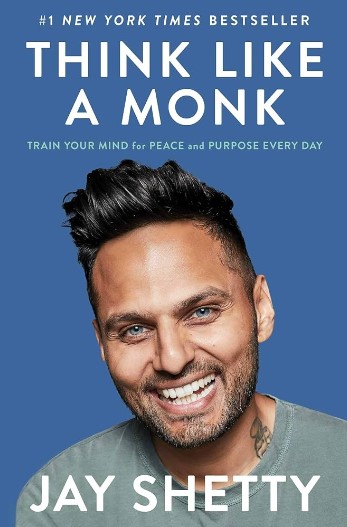Think Like A Monk by Jay Shetty
Reviewed by Michael Attard
Officially, Jay Shetty was a monk for three years. So, one might ask, “If being a monk is so great, then why did he quit?” Simply put, being a monk was not his calling. And it probably is not your calling either. But the mindset of a monk transcends time and cultures, enabling all of us to become wiser and to hopefully find our personal calling.
Part One is entitled “Let Go.” We are all products of our history, which begins at least a generation before we are born. Two of the first questions he addresses are “Who do we think we are?” and “Where do our values come from?” The author does not shun modern psychology and often uses it to provide evidence for what he states. Regarding who we think we are, he claims that our identity revolves around “what we think others think of us.” In other words, generally, we do not determine ourselves. It follows then that our values are not our own creation, but rather are defined by what we experience. Thus, in order to become wise, it is that which we are not which we must let go of.
More easily understood is the idea of letting go of negativity. Comparing, complaining, and criticizing often come from within when we feel threatened. Negativity is contagious and can lead to a victim mentality, which in turn, studies have shown, leads to a sense of entitlement. The author suggests that we let go of negativity through understanding that “the grass is greener where you water it.”
According to the author, we need to let go of fear, and the cause of fear is attachment. We often see ourselves as “I am afraid.” In your mind, detach the fear from yourself. You may have fear, but the fear is not you. The Roman Stoic philosopher Seneca observed, “Our fears are more numerous than our dangers, and we suffer more in our imagination than reality.”
In Part Two, with an unencumbered slate, we are ready to “Grow.” But the path to wisdom is still far from clear. We may know that we are seeking a purpose, but where do we search? And we cannot just choose a purpose. In his words, “You can’t be anything you want. But you can be everything you are.” Your calling can be seen as your natural state, but “its range is further than your comfort zone.”
Chapter six is entitled “Routine.” There is a wealth of knowledge in this chapter. He tells us that for the monks, “Our morning routine never varied. The simplicity and structure… spared us from the stressful complexity of decisions and variation.” He says it was like taking “a mental shower.” Waking up early was difficult for him at first, but he quickly came to see it as a very important routine. The intention is not to control or to deprive the body, but the exact opposite. “The goal is to give you enough time to move with intention and to do things completely.” For the monks, a lack of sleep “is a profound failure of self-respect and of priorities.”
In the following chapter, the author advises that we see the mind as a separate entity. The competing voices in our mind always present a dilemma. Which ones we choose to listen to will determine whether we become wise or not. Not only should we listen, but we should also talk to ourselves. Referring to studies, he says, “Talking to yourself helps clarify your thoughts, tend to what’s important and firm up any decisions you’re contemplating.” He also adds that when talking to yourself, do it with love.
The last chapter of Part Two is about the ego. He clarifies that ego is really our essence. It is the false ego that is a crafted identity. To keep the ego on an even keel, and to keep us humble, we should remember two things, and forget two things. “Remember the bad you have done to others, and the good, others have done to you.” Then “Forget the good you have done to others, and the bad others have done to you.” At the end of the chapter, he offers more good advice. “Believe those who search for the truth; doubt those who have found it.”
In Part Three, entitled “Give,” the focus shifts from looking inward to looking outward. With all of our senses wide open, we begin to appreciate everything, “especially the ordinary.” With appreciation comes gratitude. And gratitude is like a key, as it opens us up “to opportunities, not obstacles.” To be clear, gratitude is not just saying thank you; “grateful living is trust in life.”
What better place to give than in a personal relationship? And where can we be more disappointed than in a relationship? The author reminds us that we often meet people for a season, a reason, or a lifetime. We must remember: “Love is like a circle. Whatever love you give out; it always comes back to you. The problem lies with your expectations. You assume the love you receive will come from the person you gave it to.”
The book’s concluding chapter is called “Service.” This really is the epitome of what it means to be a monk. Service connects us to other people, it amplifies gratitude, it increases compassion, and it builds self-esteem. We can achieve all of this without joining a temple or a monastery. All we have to do is “Think Like A Monk.”
The Reviewer
Michael Attard is a Canadian who has lived in Gwangju since 2004. Though officially retired, he still teaches a few private English classes. He enjoys reading all kinds of books and writes for fun. When the weather is nice, you may find him on a hiking trail.







